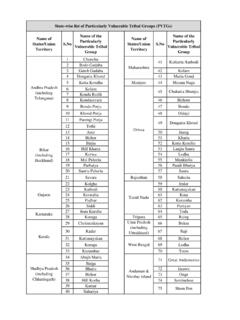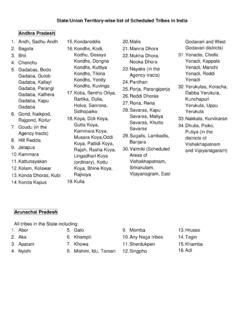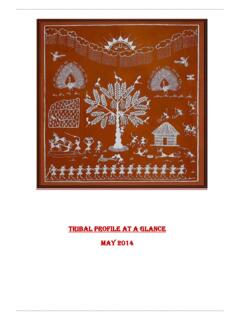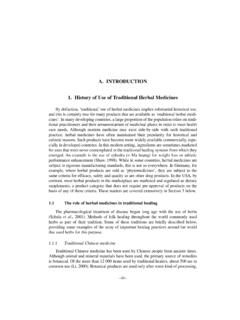Transcription of Tribal Faces in India - Ministry of Tribal Affairs
1 Tribal Faces in India Tribal Faces in India Bhil A Bhil clad in his finest for the Toranmal festival. Boys and girls gather in large numbers during such festivals as they provide an opportunity for them to choose their partners. Bhil The Bhil are one of the largest Tribal groups, living in Chhattisgarh, Gujarat, Karnataka, Madhya Pradesh, Maharashtra, Andhra Pradesh and Rajasthan. The name is derived from the word billu', which means bow. The Bhil are known to be excellent archers coupled with deep knowledge about their local geography. Traditionally, experts in guerrilla warfare, most of them today are farmers and agricultural labourers. They are also skilled sculptors. Bhil has traditional medical specialists - Budwa (Shaman) Huvarki (traditiona) birth attendant) Vaidu (herbalist). and Had Vaidu (Bone setter) with some communities having male midwives. Bhil women wear traditional saris while men are dressed in long frock and pyjama.
2 Woman put on heavy ornaments made of silver, brass along with rosaries of beads and silver coins and earing. Munda A Munda woman from Ranchi in Jharkhand wears a red-and-white gamcha (towel). wrapped around her head. The nose ring is typically worn only by older women. Munda The Munda are a tribe belonging to the Chotanagpur plateau, spread across, Jharkhand, Chhattisgarh, Madhya Pradesh, Odisha, Tripura and West Bengal. A Munda is defined by his/. her surname, which is based on natural elements such as trees, animals and birds. Mundas are fond of dance and music; their songs evoke nature in all its glory. Nupur (an anklet), is a special dance form involving wearing Nupur in ankles and dance in observe many festivals, the most important being the Magha or Ba, a thanks-giving festival celebrated in spring. Since ancient times, the Munda have been wanderers and hunters; More recently they have become cultivators. Buried ancestors are treated as guardians spirits of the khunt' or the genealogical family, symbolized by sasandiri, the burial stone.
3 Baiga A Baiga woman of Mandla in Madhya Pradesh sports elaborate tattoos all over her body. In Baiga culture, specific body parts are tattooed with specific designs depending on the age. Baiga The Baiga, meaning sorcerers, are one of the particularly vulnerable Tribal groups and are spread across Chhattisgarh, Jharkhand, Bihar, Odisha, West Bengal, Madhya Pradesh and Uttar Pradesh,. Traditionally, the Baiga lived a semi-nomadic life and practiced slash - and - burn cultivation. Now, they are mainly dependent on minor forest produce for their livelihood. Bamboo is the primary resource that they use to build houses as well as household items such as fans and baskets. Known for collecting honey using traditional techniques, the Baiga also have an in-depth knowledge of folk medicine. They have a rich cultural heritage with unique styles of music, dance and dance dramas. After a death in the family, the Baiga just leave the house and build another.
4 Tattooing is an integral part of Baiga culture every age and body part has a specific tattoo reserved for the occasion. Kokna A Kokna man with a gulel (boomerang) takes aim at an animal in Thane district, Maharashtra. KOKNA. The Kokna are a major tribe found in Gujarat, Maharashtra Karnataka, Rajasthan, Dadra and Nagar Haveli. According to anthropologists, the ancestors of the Kokna tribe were the primary inhabitants of the Konkan region and it is from their ancient dialects, that the present-day Konkani language has evolved. The Kokna are known for making masks, bamboo, wooden craft, brass and copper motifs. Kokna artists can craft ordinary wooden tobacco containers into beautiful works of art. The tribe celebrate Bohada, the famous festival of masks, which is a combination of dance and drama, celebrated during March and April. Various facial expressions are intricately highlighted in the masks. The Kokna have their own traditional panchayat that solves disputes and conflicts within the community.
5 Madia An elderly Madia woman in Hemalkasa village in Maharashtra. Madia women wear heavy ornaments; at times, their ears are almost disfigured by the weight of the earrings. madia The Madia live in Chhattisgarh, Maharashtra, Madhya Pradesh and Odisha. There are two major groups: Bada Madia, mostly concentrated in the dense forest around the Laheri hills and the Chota Madia, that lives on plains. They are primarily, a hunting-gathering tribe, The Madia are skilled in bamboo and takes special care while cutting so as not to damage the roots. Every Madia village has a ghotul (youth dormitory), where young boys and girls learn various life skills and several aspects of their culture, song, dance, and to play musical instruments. When a Madia man is engaged, he must carve a Mundha, a decorative wooden pillar to be kept in front of the ghotul during his marriage ceremony. The Mundha is perhaps the most superior example of skill in wood carving.
6 SANTHAL. A Santhal woman in Jharkhand wears a sari in the traditional style. The tribe's culture is depicted in the paintings and artworks on the walls of the typical Santhal house. Santhal The Santhal are the largest and one of the oldest tribes in India , They are spread across Assam, Bihar, Chhattisgarh, Jharkhand, Odisha and West Bengal. From time immemorial they have cleared forests, tilled the land and produced food for subsistence. They are also well-versed in the art of hunting and sericulture. The Santhal system of governance, known as Manjhi-Paragana, can be compared to local self-governance. Panchayats are a common feature, with clusters of 50-200 villages forming mega panchayats. Dancing and singing as a group is an integral part of Santhal culture. One of the most studied Tribal religions in the country. Santhals worship Marang Buru or Bonga as supreme deity. The weight of belief, however, falls on a court of spirits (Bonga), who are believed to handle different aspects of the world and who must be placated with prayers and offerings in order to ward off evil.
7 A characteristic feature of the Santhal village is a sacred grove on the edge of the settlement, considered the home of spirits. KA THAKAR. A Ka Thakar woman in Thane, Maharashtra. Ka Thakar women wear a two-piece sari; one parts forms the skirt and the other is tucked at the waist and draped over the head. KA THAKAR. The Ka Thakar, together with Ma Thakar and Thakar, are primarily found in Thane, Raigad, Pune, Ahmednagar and Nashik districts of Maharashtra. Traditionally, the Thakars lived in the hilly forest areas of the Sahyadri range but are now found all over the state. A Thakar settlement is called a Thakarwadi. The Thakars are small cultivators, gatherers of minor forest produce, occasional fishermen, daily-wage labourers and are also skillful bamboo artisans. The Thakars have a rich tradition of folk dance and songs. Their celebration of Diwali is rather unique. On this occasion, they light lamps made from a fruit called Chibra, which are placed on a stand made of dung.
8 Warli A warli man playing Tarpa (musical instrument) in Thane district. Warli are nature worshipers and have a deep respect for wild life . Warli The Warli are spread across Thane, Nashik and Dhule districts of Maharashtra, Valsad district of Gujarat, Karnataka Goa and the Union territories of Dadra & Nagar Haveli and Daman & Diu. The Warli are small-scale cultivators and cultivate rice, pulses and vegetables. They also sell toddy, mahua and fuel wood to their tribesmen and neighbouring communities for a living. Warli are nature worshippers. Warli art stems from their belief system shaped by their centuries-old subsistence on forest land. The Warli did not have a written word until recent times and their art was a way of transmitting their belief systems from one generation to the next. Their drawings revolve around community traditions, the tools they use and their association with nature. Koli Dhor A Koli Dhor woman in Thane, Maharashtra.
9 Although their traditional vocation was the tanning of cattle hide, many are involved in agricultural pursuits nowadays. Koli Dhor The Koli Dhor live mainly in the Sahyadri range of mountains forming part of the Western Ghats and are principally found in the districts of Thane, Nashik Dadar and Nagar Haveli, Rajasthan, Karnataka, Gujarat and greater Bombay. The Koli Dhor derived their name from the word dhor', meaning cattle. Although their traditional vocation has been the tanning of cattle hide, increasingly, today many are involved with agricultural pursuits. The Koli Dhor settlements are known as wadi. The houses are square or rectangular huts built on a layer of earth with or without plinth. The material used consist of sticks, bamboos, wooden poles, rice hay, mud and cowdung plaster. As a majority of them are poor and landless, they migrate to nearby cities and towns to work as daily labourers and return to their villages only in June, to work as agricultural and daily-wage labourers.
10 BIRHOR. A Birhor woman with her daughter in Hazaribaug district Jharkhand. Birhor The Birhor are a nomadic hunting-gathering tribe found in Jharkhand and neighbouring areas of Chhattisgarh, West Bengal, Odisha, Bihar and Madhya Pradesh. They have been classified as a particularly vulnerable Tribal group. Tribe members practice shifting cultivation. Birhor live in small settlements called tanda at the edge of the forest. Expert hunters, they use nets and snares for catching small animals and birds. Nets made of strong fibre spread from tree to tree are used to trap monkeys. They also collect honey. The practice of barter still exists. The Birhor religion presents a mixture of animism, animatism, naturalism, worship and belief in spirits. KORKU. A Korku man plays the traditional flute called Bhugadu in Khandwa district in Madhya Pradesh. During Diwali, the men go from door to door, playing the flute. KORKU. The Korku are mostly found in the Khandwa, Burhanpur, Betul and Chhindwara districts of Madhya Pradesh, Chhattisgarh, and adjoining Melghat region of Maharashtra.










